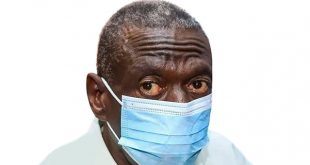
By Haggai Matsiko
Police chief’s new term begins years amidst stiff criticism as his force celebrates a hundred
Inside the Uganda Police Force command centre on the second floor of the three-storeyed Shs9 billion plush Police headquarters located in Naguru in Kampala, about 30 police officers, neatly clad in khaki uniforms pick emergence calls as others look at the over 20 giant screens.
Almost covering the entire wall, the joined screens relay video feed from the hundreds of cameras installed at different points in Kampala city.
In this command centre, police can tell which traffic officer is absconding from duty or taking a bribe or which person is committing a crime in different parts of Kampala.

A few minutes away from the three-storeyed headquarter is the new forensic laboratory that emerged the best in the whole region and was chosen to be the regional centre.
The day The Independent visited the CIID headquarters, currently housing the entire force’s head offices, there was a meeting was under way in the boardroom about the activities to celebrate the Oct.3 centenary celebrations.
Themed; “From Colonial Policing to Community Policing; A Century of Challenges, Achievements and Transformation” the celebrations offer the police leadership a good moment to reflect.
According Dr. Jude Kagoro, a lecturer at Bremen University, Germany, it is Inspector General of Police (IGP) Kale Kayihura’s tenure that has seen the force transform rapidly.
“Specifically,” Kagoro noted at the Erinayo Oryema Police Centenary Memorial Lecture held at Makerere University on Sept.16, “the period between 2005 to date has seen the most tremendous transformation of the police in terms of funding, command and control, numbers, discipline as well as technological aspects.”
At the same Oryema lecture, Kayihura noted that his target is to fully transform the Uganda police into a modern, service-oriented, professional and pro-people institution.
The Kayihura effect
Just like his letter seeking re-appointment, which leaked in August showed, Kayihura could easily spend a whole day talking about how he has turned around police.
The institution’s budget has grown from Shs74 billion in 2005/2006 to Shs412 billion in 2014/2015. When Kayihura in 2013 moved the police headquarters from rented premises to the three-storeyed CIID headquarters, he saved the police billions in annual rent charges.
From zero in 2004, the police now have 30 Armoured Personnel Carriers (APCs), and 21 ambulances. Patrol pickups have also increased from 125 to 591, troop carriers from 0 to 32, saloon cars from 41 to 232 and motorcycles from 0 to 3,556 among others. This increase has improved the force’s mobility in response to crime across the country. The police has become an attractive career destination too with thousands of young university graduates flocking to join the force’s ranks. Early last year, for instance, Kagoro’s visit at the Kibuli (Kampala) recruitment centre revealed that despite the police having advertised for 500 officer cadet positions, over 4500 young graduates turned up to try out their luck.
Even rural police stations across the country are headed by graduates a trend that has transformed the quality of relations between the citizens and the police, Kagoro argues. Weighed against the historical context where the police was predominantly a field of the semi-illiterates, Kagoro says that a claim can be made that the image of the police has substantially improved.
Kayihura is also quick to point to the increasing numbers. Police numbers have also grown from 18,000 in 2005 and about 43,668 at present, he wrote to the police authority. This puts the police: population ratio at 1: 709. The United Nations recommended ratio is 1:500. Having secured a cabinet decision to recruit 2,500 officers annually, Kayihura hopes that police can easily hit the 70,000 target and meet the UN standard.
Having built the Police Training School at Kabalye and planning to establish the Public Order Management Centre in Yumbe, and the Counter Terrorism Centre, Olilim, Katakwi, Kayihura is not too far from meeting this standard and improve police performance. The police chief is also in advanced stages to construct a Shs.9.6 billion police college at Bwebajja in Entebbe and there are plans to set up a police university in future.
All these are certainly no small dreams or mean feats. They are perhaps the reason the police chief was easily able to receive a nod to get another term of three years, from the institution’s top governing authority—the Police Authority.
Kagoro notes that evidence shows that the Uganda police’s capacity in the maintenance of order, enforcement of law as well as prevention and detection of crime has greatly improved.
He says that the increase in police numbers has augmented police strength, visibility, and penetrative ability of society. Kagoro also hails the community policing model that Kayihura introduced saying it reduces citizens’ fear of crime, betters society’s quality of life, and improves police’s legitimacy in the hearts and minds of the people.
Muyenga model
Kayihura, together with a community in Muyenga, established a community policing model popularly referred to as the “Muyenga Model”.
Increasingly, the police have been actively training willing citizens in crime prevention with a view, not only to empowering them about crime deterrence and the components of law, but to also encourage acceptance of responsibility for law and order in their locality.
A number of interest groups such as boda-boda riders, taxi drivers, markets vendors, and recently, in June 2014, over six hundred students drawn from several universities were passed-out at the police training school in Masindi.
But as Kayihura presides over the centenary celebrations, he also finds himself confronted with a lot of criticism over some of these developments.
In their September report, legislators who sit on parliamentary committee on Defence and Internal Affairs cautioned against the current wave of training civilians without a clear framework. They recommended that the Internal Affairs Minister comes up with a statutory instrument to formalise the recruitment of crime preventers in order to do away with suspicion that police is creating a militia.
Legislators like Semujju Ibrahim Nganda, the opposition Kyadondo East legislator, who sits on the Defence and Internal Affairs committee, have long argued that all the police chief is keen on is pursuing opposition politicians.
Indeed, leaked tapes in which Kayihura was heard preaching against former Prime Minister, Amama Mbabazi and Elias Lukwago, seemed to lend credence to these claims. Apart from this, Kayihura has also had run-ins with the members of parliament who accuse him of superintending over a highly militarised, political and unprofessional force. Concerns about Kayihura’s leadership range from the police’s connections with criminal groups like the Kiboko Squad, basing recruitment, training and promotions on allegiance to the NRM party other than qualifications, performance and experience, poor police living conditions in the police barracks, among others.
These issues, critics say, contradict what the force leadership is calling a shift to community policing. These accusations gained more traction when retired Senior Assistant Commissioner of Police Herbert Karugaba, declined to be part of the centenary celebrations in protest of what he detailed as the way Kayihura runs the police. Karugaba’s letter to the IGP remains the most hair-raising critique of Kayihura’s reign.
“You have turned the UPF from a civilian law enforcement agency into a highly militarised goon squad specifically aimed at controlling the grey area between what constitutes crime and politics,” Karugaba wrote to Kayihura, “In this effort, opposition to authoritarian rule has been criminalised, and any opposition to NRM is now considered unpatriotic, and thus “crime” has been politicised. “
Others like Masaka municipality’s Mathias Mpuuga have even called for Kayihura’s resignation. The leadership of the Uganda People’s Congress (UPC), last month even called on parliament not to renew Kayihura’s contract.
Praise amidst criticism
Another point of reflection is that while the command centre, the CIID state-of-the-art building and the forensic laboratory, among others, are seen as visible symbols of transformation of police under Gen.Kayihura’s leadership, the force still faces red flags that are also more pronounced.
For instance, while the police headquarters is shining with state of the art buildings, the sight at Kiira road police station, where huge commercial posters have been used to hide the rundown barracks raises an alarm about police welfare. Despite having established an engineering unit, which is supposed to construct accommodation facilities, the police remain in dire need of housing. Only 24 percent of the force is housed.
Reports about corruption and brutality in the force have not helped matters. Year on year, bodies including the Inspector General of Police have ranked the Uganda police among the most corrupt institutions.
Video footage showing the police and the military beating up residents of Kasese following attacks on some security installations in July have renewed concerns about police brutality.
But President Museveni early this year praised Kayihura for cracking down on the opposition with tear gas. Speaking on Jan. 13 at the East African Police Chiefs Cooperation Organisation meeting at the luxurious Paraa Safari Lodge in Uganda’s Murchison National Game Park, Museveni said Kayihura had found the perfect antidote to mass opposition protests.
Museveni was speaking about “the recent wave of violence and instability in North Africa and its implications to our region and the rest of Africa”.
He said his police boss had found a formula for such protests.
“This man,” he said pointing at Kayihura, “has enough tear gas”. “Once the demonstrators take enough smoke, they go home,” he added.
Indeed, quelling protests has partly been a cost driver for police. For instance, just after the 2011 elections when demonstrations were at their most intense, the police fuel bill hit the Shs20 billion mark. Over all, Shs150 billion was spent on efforts and machinery related to quelling riots.
In the annual budget performance report, it is indicated the money financed, among others, the handling of 57 cases of public order, 49 cases of incitement to violence, six election related cases, and one case was of promoting sectarianism, among others.
Most of these demonstrations, police noted, were carried out by the Activist for Change (A4C), the report noted.
This is why the parliamentary committee on Defence and Internal Affairs, asked police to “work within limited resources” and adapt more cost effective and yet efficient methods of policing such as “community policing and soft power that are less coercive and yet cost effective”.
But experts in policing, like Dr Kagoro, argue that looking at quelling riots as the main distorts the true picture of what police does considering that quelling riots does not even constitute 90 per cent of what police does. With his big ambitions and the mandate after securing another term, police chief Kale Kayihura has a chance to address these concerns. Meanwhile, his critics will be watching.
 The Independent Uganda: You get the Truth we Pay the Price
The Independent Uganda: You get the Truth we Pay the Price


